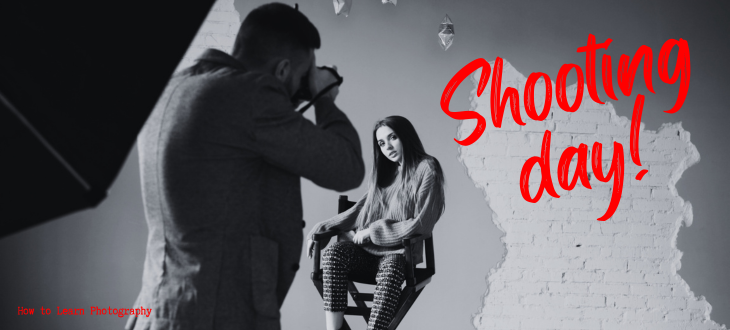The photography process can be broken down into three main stages: pre-production (planning), production (capturing the image), and post-production (processing the image)(optional). Here's a closer look at each:

Pre-production
The pre-production stage in photography involves careful planning and preparation before starting the shoot. A well-planned pre-production stage can ensure a smooth and successful shoot. Here's a breakdown of the key steps involved:
Concept and Planning:
Brainstorming & Defining Goals: This is where you discuss the project's purpose and vision. Are you working with a client? What kind of images do they need? What story are you trying to tell?
Budgeting: Determine your budget for the shoot, including equipment rental, location scouting, props, and hiring assistants.
Logistics and Preparation:
Location Scouting: If you're not shooting in a studio, finding the perfect location is essential. Consider factors such as lighting, background elements, and equipment accessibility.
Shot List & Storyboarding: Create a shot list outlining the specific photographs you want to capture. A storyboard can further visualize the composition and flow of the shoot.
Equipment Selection: When selecting a camera and lenses, consider lighting conditions and the desired photo type. Additionally, think about any necessary equipment, such as tripods, filters, or lighting setups.
Pre-visualization and Communication:
Mood Board Creation: Creating a mood board is essential for ensuring everyone involved is on the same page creatively, as it visually represents the desired aesthetic and mood for the photographs.
Crew Coordination: If you're working with a team (stylists, makeup artists, assistants), clearly communicate the plan and delegate tasks effectively.
Client Communication: During client projects, regularly update them throughout the pre-production process and discuss any concerns to ensure their satisfaction with the planned direction.
Test Shoot (Optional): In some cases, it can be helpful to conduct a test shoot prior to the main shoot to experiment with lighting, composition, and styling concepts.
Thorough pre-production planning can help avoid problems on shoot day and improve the chances of capturing your desired vision in stunning photographs.

Production
The production stage of photography is where the planning and preparation of pre-production comes to fruition. This is where you put all your preparation into action and capture the actual images. Here's a breakdown of what typically happens during a photography shoot:
Setting Up and Preparation:
Arrival and Setup: Make sure to arrive at the shoot location early to have enough time to set up equipment and arrange the scene based on your shot list.
Lighting Setup: If using artificial lighting, position your lights to achieve the desired lighting effect. If using natural light, be prepared to adapt based on the time of day and weather conditions.
Capturing the Images:
Working with the Subject(s): If you photograph people or animals, it's important to make them feel comfortable and give clear instructions to capture the expressions and poses you want.
Composition and Focus: Pay close attention to composition techniques and ensure your subject is in sharp focus for impactful photos.
Reviewing and Adjusting: It's important to take frequent breaks to review the photos you've captured and make any necessary adjustments to the composition, lighting, or camera settings.
Experimentation: During the shoot, stick to your shot list but don't be afraid to experiment with different angles and creative ideas.
Collaboration and Communication:
Client Feedback (if applicable): If working with a client, keep them informed and incorporate their feedback throughout the shoot to ensure they're happy with the progress.
Teamwork: If you have a photography team, work collaboratively, communicate effectively, and delegate tasks to ensure a smooth workflow.
Wrapping Up:
Backup and Safekeeping: Regularly back up your captured photos onto external storage devices to avoid data loss.
Breaking Down the Set: After taking all the required photos, pack your equipment carefully and leave the location in the same condition as you found it.
During a shoot, unexpected situations may arise. Staying positive, adaptable, and resourceful is crucial for overcoming any issues.

Post-production
The post-production stage of photography is the point where you take the raw images that were captured during the shoot and transform them into polished final photographs. While some photographers choose minimal edits or none at all, post-processing offers a powerful toolbox to enhance your photos and bring your creative vision to life. Here's a closer look at the typical post-production workflow:
Importing and Organizing: Transfer your photos from your camera to your computer and efficiently organize them.
Culling and Selecting: Review all your captured photos and select the best ones to move forward with editing. Look for images that are sharp, well-composed, and effectively represent your vision.
Basic Edits and Adjustments: These edits are often applied globally to all your selected photos. Common adjustments include:
Exposure and Contrast: Fine-tuning the overall brightness and contrast of the image.
White Balance: Ensuring accurate color representation by adjusting the white balance to match the lighting conditions under which the photo was taken.
Cropping and Straightening: Cropping to improve composition and straightening any tilted horizons.
Advanced Editing and Local Adjustments: This is where you can get more creative and make selective edits to specific areas of your photos. Here are some popular techniques:
Color Grading: Adjusting the overall color palette of the image to create a specific mood or style.
Dodging and Burning: Lightening or darkening specific areas of the image to draw attention or enhance depth.
Noise Reduction: Minimizing unwanted grain or noise that may be present in the image, especially in low-light situations.
Sharpening: Enhancing the image's clarity and definition.
Creative Editing (Optional): This stage allows for more artistic expression. You can apply filters, textures, and overlays, or use tools like cloning and healing to remove blemishes or unwanted objects.
Exporting and Saving: Once you're happy with your edits, export your final photos in the desired format and resolution, considering how you plan to use them (printing, web sharing, etc.).
Additional Considerations:
Non-Destructive Editing: It's recommended to use non-destructive editing techniques whenever possible. This allows you to go back and make adjustments to the original image data without losing quality.
Software Selection: Many photo editing software programs are available, each with its strengths and functionalities. Popular choices include Adobe Photoshop, Lightroom, Skylum Luminar, and GIMP (free, open-source option).
Calibration and Consistency: Ensure your monitor is properly calibrated to represent colors accurately for reliable editing. Develop a consistent editing style for a cohesive look across your photography portfolio.
By mastering post-production, you can elevate your photos to a professional level that showcases your creative vision.
I hope this gives you a good overview of the photography process.
Did you find this information helpful? Please consider buying me a coffee. Your support will be much appreciated.
Join the Think Adventure Community and Stay in the Loop - Sign up! 🖊️📧
Some helpful links. 👇
Personal Insurance 🏥👨👩👧👦💰
Read Next: Coming Soon

